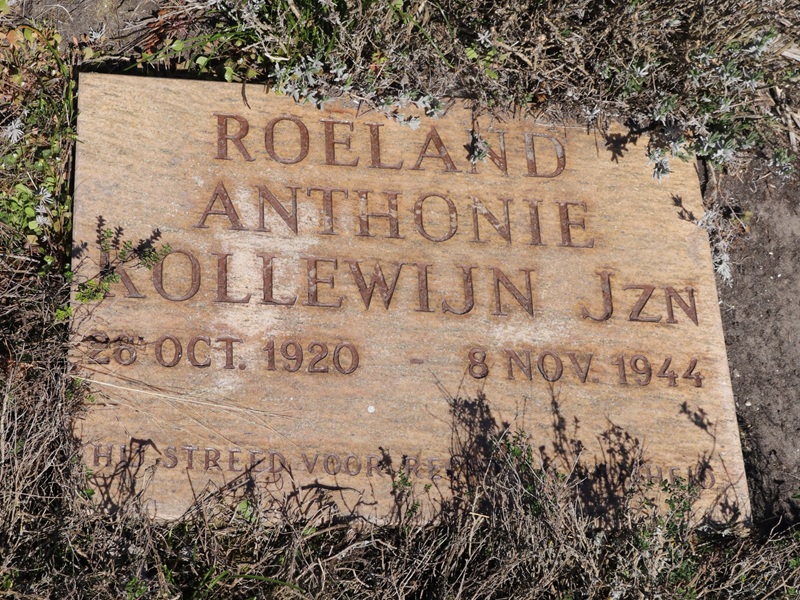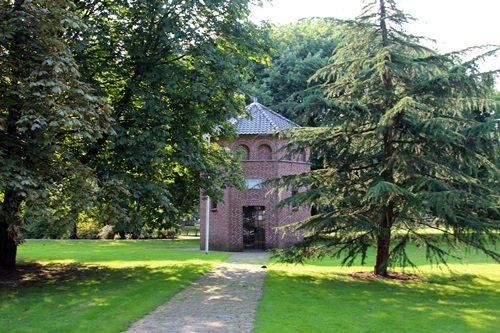Kollewijn, Roeland Anthonie
- Date of birth:
- October 26th, 1920 (Amsterdam/North Holland, Netherlands)
- Date of death:
- November 8th, 1944 (Delft/South Holland, Netherlands)
- Buried on:
- Dutch Honorary Cemetery Bloemendaal
Plot: 40. - Nationality:
- Dutch
Biography
Lived - according to the death certificate - in Delft. He is also known to have lived at 12 Watermolenwal in Helmond. Son of doctor Jacobus Roeland Kollewijn (22 February 1887 Amsterdam) and Alida la Fontaine (doctor, 3 October 1887 Pati, Dutch East Indies). Unmarried (engaged to Aleid Nijenhuis). Named after his grandfather Roeland Anthonie Kollewijn (teacher and director of secondary school/prominent linguist and man of letters, 30 March 1857 Amersfoort - 7 February 1942 Helmond). Grew up in Helmond. Studied for a year at the Technical University in Zurich and from 1938 was a student of electrical engineering at the Technical University in Delft. No church. Member of the resistance under the pseudonyms Van Buuren, J.G. van Wijk and Van Doorne. With the latter pseudonym, Roes (as he was known) made a link to his grandfather, who used the pseudonym C.P. Brandt van Doorne in his publicity work. He was part of the resistance group around the Delft professor of physics, Prof. Dr Eliza Cornelis Wiersma. Kollewijn maintained contact between Wiersma and the KP, the LO and the Council of Resistance. In consultation with Wiersma, who died on 31 July 1944 at the age of just 42 from the effects of severe rheumatoid arthritis, and the Leiden professor of physics Wander Johannes de Haas (1878-1960), Kollewijn researched a method at the Kamerlingh Onnes Laboratory in Leiden for forging identity cards in such a way that they could not be distinguished from the . He also experimented with the manufacture of explosives. In addition, he provided people in hiding with false identity cards and Ausweise. In his book about Delft in World War II, De Blij writes that thanks to him, many Dutch Jews escaped the Germans. According to this author, he also did ‘meritorious work’ as a spy. Unlike almost all of his fellow student resistance fighters, he did sign the declaration of loyalty. Wiersma's opinion may have influenced him. The professor was opposed to the closure of the university of applied sciences. He felt that after the liberation, which he expected soon, the Netherlands needed engineers who had recently graduated or would do so in the near future. Kollewijn was not criticised posthumously for signing the declaration of loyalty. A post-war letter from rector magnificus H.J. van der Maas of the Delft University of Technology to his parents, quoted by Heere and Vernooij, states: ‘During the occupation, a number of students signed the declaration of loyalty with the express purpose of being able to continue their already begun illegal work in this way... ...He (Kollewijn, ed.) had to remain silent for the sake of his work and persisted in doing so even when people misinterpreted his position... ... It is a great privilege for me to be able to inform you that the Purification Committee for students spoke of his work with great respect and that, had he still been alive, I would have immediately admitted him to study at the Technical College. I would like to express my sincere and heartfelt condolences for the loss of this great patriot.’ On 3 November 1944, the Landwacht (a paramilitary organisation) raided the building at Noordeinde 32. Students who collaborated with the Delft KP were living at that address. Resident Roes Kollewijn opened the door and, according to De Blij, was immediately hit by bullets. During the ensuing shootout, student Pieter Fentener van Vlissingen and office worker Jan van der Woude were also wounded. The next day, the group moved to another location. Sten guns, pistols and hand grenades had already been packed, leaving the students with only pistols. The weapons were found, as were the crashed American pilot Paul Kutzar and the seriously wounded Kollewijn, who had hidden in a shelter on the third floor. The wounded were cared for in the Oude and Nieuwe Gasthuis in Delft under the permanent guard of the Landwacht and Grüne Polizei. On 8 November 1944 Kollewijn succumbed to his serious injuries. His fiancée visited him in hospital disguised as a nurse. Two days earlier, Fentener van Vlissingen and seven other resistance fighters had been executed by firing squad on the Waalsdorpervlakte. Kollewijn's name is inscribed on the memorial in the hall of the auditorium of the Technical University on Mekelweg in Delft.
In November 1944 Kollewijn was buried at the Jaffa Cemetery in Delft under his pseudonym, engineer J.G. van der Wijk. On 11 July 1946 he was reburied at the War Cemetery.
Do you have more information about this person? Inform us!
Sources
- Photo 1: Eerebegraafplaats Bloemendaal
- Photo 2: Arjo Eijgelsheim
- - Helmonds Heem.
- Death certificate.
- Heere en Vernooij; De Blij, Oorlog en verzet in de Prinsenstad 1940-1945: een overzicht van de gebeurtenissen in Delft in en rond de bezettingstijd; Dirk van Delft, Tegen de roof: Het Kamerlingh Onnes Laboratorium in oorlogstijd, Gewina, deel 30, jaargang 2007, nummer 4, pag 247-264; Oorlogsgravenstichting; Digitale Stamboom (Delft, Eindhoven), waaronder overlijdensakte 1310/1945 gemeente Delft; genealogieonline (stamboom Van der Velden, Gesink, Blonk Seijmonsbergen vd Geur). Zie over opa Kollewijn: J. Noordegraaf, Kollewijn, Roeland Anthonie (1857-1942), in: Biografisch Woordenboek van Nederland, site resources.huygens.knaw.nl. - Eerebegraafplaats Bloemendaal





